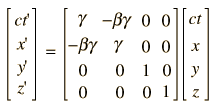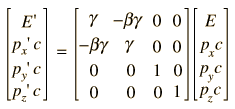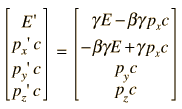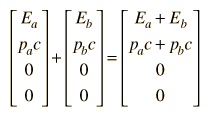Four-vectors in Relativity
In the literature of relativity, space-time coordinates and the energy/momentum of a particle are often expressed in four-vector form. They are defined so that the length of a four-vector is invariant under a coordinate transformation. This invariance is associated with physical ideas. The invariance of the space-time four-vector is associated with the fact that the speed of light is a constant. The invariance of the energy-momentum four-vector is associated with the fact that the rest mass of a particle is invariant under coordinate transformations.
The space-time 4-vector is defined by 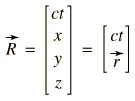 | The energy-momentum 4-vector is defined by 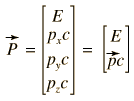 |
|
The scalar product of two space-time 4-vectors is defined by  and the scalar product of two energy-momentum 4-vectors by  Note that this differs from the ordinary scalar product of vectors because of the minus sign. That minus sign is necessary for the property of invariance of the length of the 4-vectors. | |
The length of the space-time 4-vector squared is given by  The length of a 4-vector is invariant, being the same in every inertial frame. This invariance is associated with the constancy of the speed of light. This expression can be seen to be the equation of a sphere, with light propagating outward from the origin at speed c in all directions so that the radius of the sphere at time t is ct. | The length of the energy-momentum 4-vector is given by  The length of this 4-vector is the rest energy of the particle. The invariance is associated with the fact that the rest mass is the same in any inertial frame of reference. |
| Lorentz transformation in 4-vector form |
| Four-vector sum for momentum-energy |
Reference
Rohlf
Sec 4-4
| HyperPhysics***** Relativity | R Nave |
